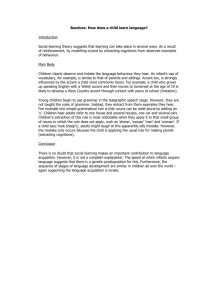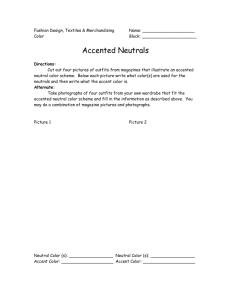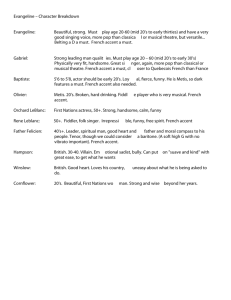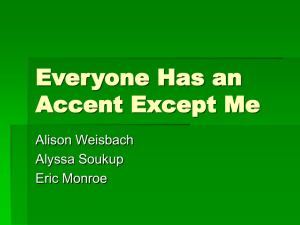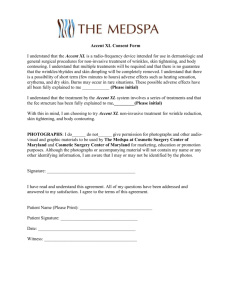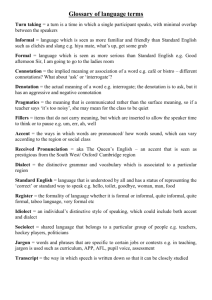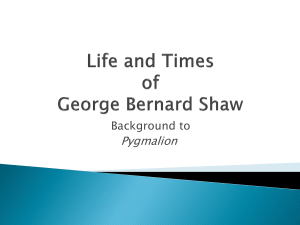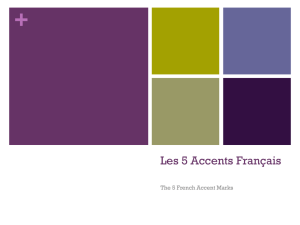224s.14.lec13 - Stanford University
advertisement
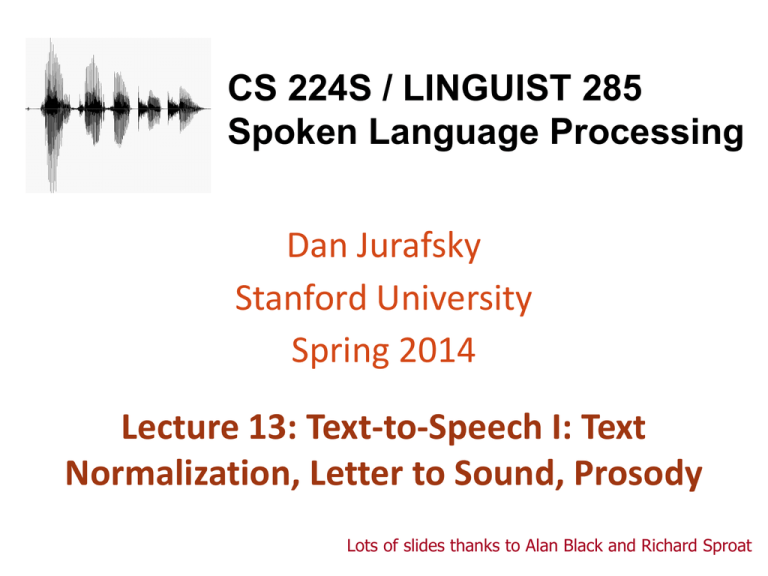
CS 224S / LINGUIST 285 Spoken Language Processing Dan Jurafsky Stanford University Spring 2014 Lecture 13: Text-to-Speech I: Text Normalization, Letter to Sound, Prosody Lots of slides thanks to Alan Black and Richard Sproat Outline History, Demos Architectural Overview Stage 1: Text Analysis Text Normalization Tokenization End of sentence detection Homograph disambiguation Letter-to-sound (grapheme-to-phoneme) Prosody Dave Barry on TTS “And computers are getting smarter all the time; scientists tell us that soon they will be able to talk with us. (By “they”, I mean computers; I doubt scientists will ever be able to talk to us.) History of TTS Pictures and some text from Hartmut Traunmüller’s web site: http://www.ling.su.se/staff/hartmut/kemplne.htm Von Kempeln 1780 b. Bratislava 1734 d. Vienna 1804 Leather resonator manipulated by the operator to try and copy vocal tract configuration during sonorants (vowels, glides, nasals) Bellows provided air stream, counterweight provided inhalation Vibrating reed produced periodic pressure wave Von Kempelen: Small whistles controlled consonants Rubber mouth and nose; nose had to be covered with two fingers for non-nasals Unvoiced sounds: mouth covered, auxiliary bellows driven by string provides puff of air From Traunmüller’s web site Closer to a natural vocal tract: Riesz 1937 Homer Dudley 1939 VODER Synthesizing speech by electrical means 1939 World’s Fair Homer Dudley’s VODER •Manually controlled through complex keyboard •Operator training was a problem An aside on demos That last slide exhibited: Rule 1 of playing a speech synthesis demo: Always have a human say what the words are right before you have the system say them The 1936 UK Speaking Clock From http://web.ukonline.co.uk/freshwater/clocks/spkgclock.htm The UK Speaking Clock July 24, 1936 Photographic storage on 4 glass disks 2 disks for minutes, 1 for hour, one for seconds. Other words in sentence distributed across 4 disks, so all 4 used at once. Voice of “Miss J. Cain” A technician adjusts the amplifiers of the first speaking clock From http://web.ukonline.co.uk/freshwater/clocks/spkgclock.htm Gunnar Fant’s OVE synthesizer Of the Royal Institute of Technology, Stockholm Formant Synthesizer for vowels F1 and F2 could be controlled From Traunmüller’s web site Cooper’s Pattern Playback Haskins Labs for investigating speech perception Works like an inverse of a spectrograph Light from a lamp goes through a rotating disk then through spectrogram into photovoltaic cells Thus amount of light that gets transmitted at each frequency band corresponds to amount of acoustic energy at that band Cooper’s Pattern Playback Pre-modern TTS systems 1960’s first full TTS: Umeda et al (1968) 1970’s Joe Olive 1977 concatenation of linear- prediction diphones Texas Instruments Speak and Spell, June 1978 Paul Breedlove Types of Synthesis Articulatory Synthesis: Model movements of articulators and acoustics of vocal tract Formant Synthesis: Start with acoustics, create rules/filters to create each formant Concatenative Synthesis: Use databases of stored speech to assemble new utterances. Diphone Unit Selection Parametric (HMM) Synthesis Trains parameters on databases of speech Text modified from Richard Sproat slides 1980s: Formant Synthesis Were the most common commercial systems when computers were slow and had little memory. 1979 MIT MITalk (Allen, Hunnicut, Klatt) 1983 DECtalk system based on Klatttalk “Perfect Paul” (The voice of Stephen Hawking) “Beautiful Betty” 1990s: 2nd Generation Synthesis Diphone Synthesis Units are diphones; middle of one phone to middle of next. Why? Middle of phone is steady state. Record 1 speaker saying each diphone ~1400 recordings Paste them together and modify prosody. 3rd Generation Synthesis Unit Selection Systems All current commercial systems. Larger units of variable length Record one speaker speaking 10 hours or more, Have multiple copies of each unit Use search to find best sequence of units Future? Parametric Synthesis Most academic research Also called HMM Synthesis Train a statistical model on large amounts of data. TTS Demos: Diphone, Unit-Selection and Parametric Festival http://www.cstr.ed.ac.uk/projects/festival/more voices.html Google: chromeextension/::chhkejkkcghanjclmhhpncachhgejoel:ttsdemo.html Cereproc https://www.cereproc.com/en/products/voices The two stages of TTS PG&E will file schedules on April 20. 1. Text Analysis: Text into intermediate representation: 2. Waveform Synthesis: From the intermediate representation into waveform Outline History of Speech Synthesis State of the Art Demos Brief Architectural Overview Stage 1: Text Analysis Text Normalization Phonetic Analysis Letter-to-sound (grapheme-to-phoneme) Prosodic Analysis Text Normalization Analysis of raw text into pronounceable words: Sentence Tokenization Text Normalization Identify tokens in text Chunk tokens into reasonably sized sections Map tokens to words Tag the words Text Processing He stole $100 million from the bank It’s 13 St. Andrews St. The home page is http://www.stanford.edu Yes, see you the following tues, that’s 11/12/01 IV: four, fourth, I.V. IRA: I.R.A. or Ira 1750: seventeen fifty (date, address) or one thousand seven… (dollars) Text Normalization Steps Identify tokens in text 2. Chunk tokens 3. Identify types of tokens 4. Convert tokens to words 1. Step 1: identify tokens and chunk Whitespace can be viewed as separators Punctuation can be separated from the raw tokens For example, Festival converts text into ordered list of tokens each with features: its own preceding whitespace its own succeeding punctuation Important issue in tokenization: end-of-utterance detection Relatively simple if utterance ends in ?! But what about ambiguity of “.”? Ambiguous between end-of-utterance, end- of-abbreviation, and both My place on Main St. is around the corner. I live at 123 Main St. (Not “I live at 151 Main St..”) Rules/features for end-of-utterance detection A dot with one or two letters is an abbrev A dot with 3 cap letters is an abbrev. An abbrev followed by 2 spaces and a capital letter is an end-of-utterance Non-abbrevs followed by capitalized word are breaks Simple Decision Tree The Festival hand-built decision tree for end-of-utterance ((n.whitespace matches ".*\n.*\n[ \n]*") ;; A significant break in text ((1)) ((punc in ("?" ":" "!")) ((1)) ((punc is ".") ;; This is to distinguish abbreviations vs periods ;; These are heuristics ((name matches "\\(.*\\..*\\|[A-Z][A-Za-z]?[A-Za-z]?\\|etc\\)") ((n.whitespace is " ") ((0)) ;; if abbrev, single space enough for break ((n.name matches "[A-Z].*") ((1)) ((0)))) ((n.whitespace is " ") ;; if it doesn't look like an abbreviation ((n.name matches "[A-Z].*") ;; single sp. + non-cap is no break ((1)) ((0))) ((1)))) ((0))))) Problems with the previous decision tree Fails for Cog. Sci. Newsletter Lots of cases at end of line. Badly spaced/capitalized sentences More sophisticated decision tree features Prob(word with “.” occurs at end-of-s) Prob(word after “.” occurs at begin-of-s) Length of word with “.” Length of word after “.” Case of word with “.”: Upper, Lower, Cap, Number Case of word after “.”: Upper, Lower, Cap, Number Punctuation after “.” (if any) Abbreviation class of word with “.” (month name, unit- of-measure, title, address name, etc) From Richard Sproat slides Sproat EOS tree From Richard Sproat slides Some good references on end-ofsentence detection David Palmer and Marti Hearst. 1997. Adaptive Multilingual Sentence Boundary Disambiguation. Computational Linguistics 23, 2. 241-267. David Palmer. 2000. Tokenisation and Sentence Segmentation. In “Handbook of Natural Language Processing”, edited by Dale, Moisl, Somers. Steps 3+4: Identify Types of Tokens, and Convert Tokens to Words Pronunciation of numbers often depends on type. Three ways to pronounce 1776: Date: seventeen seventy six Phone number: one seven seven six Quantifier: one thousand seven hundred (and) seventy six Also: 25 Day: twenty-fifth Festival rule for dealing with “$1.2 million” (define (token_to_words utt token name) (cond ((and (string-matches name "\\$[0-9,]+\\(\\.[0-9]+\\)?") (string-matches (utt.streamitem.feat utt token "n.name") ".*illion.?")) (append (builtin_english_token_to_words utt token (string-after name "$")) (list (utt.streamitem.feat utt token "n.name")))) ((and (string-matches (utt.streamitem.feat utt token "p.name") "\\$[0-9,]+\\(\\.[0-9]+\\)?") (string-matches name ".*illion.?")) (list "dollars")) (t (builtin_english_token_to_words utt token name)))) Rules versus machine learning Rules/patterns Simple Quick Can be more robust Easy to debug, inspect, and pass on Vastly preferred in commercial systems Machine Learning Works for complex problems where rules hard to write Higher accuracy in general Worse generalization to very different test sets Vastly preferred in academia Machine learning for Text Normalization Sproat, R., Black, A., Chen, S., Kumar, S., Ostendorf, M., and Richards, C. 2001. Normalization of Non-standard Words, Computer Speech and Language, 15(3):287-333 NSW examples: Numbers: 123, 12 March 1994 Abbreviations, contractions, acronyms: approx., mph. ctrl-C, US, pp, lb Punctuation conventions: 3-4, +/-, and/or Dates, times, urls, etc How common are NSWs? Word not in lexicon, or with non-alphabetic characters (Sproat et al 2001, before SMS/Twitter) Text Type novels % NSW 1.5% press wire 4.9% e-mail 10.7% recipes 13.7% classified 17.9% How common are NSWs? Word not in gnu aspell dictionary (Han, Cook, Baldwin 2013) not counting @mentions, #hashtags, urls, Twitter: 15% of tweets have 50% or more OOV Twitter variants Han, Cook, Baldwin 2013 Category Example % Letter changed (deleted) Slang Other Number Substitution Letter and Number shuld 72% lol sucha 4 (“for”) 12% 10% 3% b4 (“before”) 2% State of the Art for Twitter normalization Simple one-to-one normalization (map OOV to a single IV word) Han, Cook, and Baldwin 2013 Create a typed-based dictionary of mappings tmrw -> tomorrow Learned over a large corpus by combining distributional similarity and string similarity 4 steps to Sproat et al. algorithm Splitter (on whitespace or also within word (“AltaVista”) Type identifier: for each split token identify type Token expander: for each typed token, expand to words Deterministic for number, date, money, letter sequence Only hard (nondeterministic) for abbreviations Language Model: to select between alternative pronunciations From Alan Black slides Step 1: Splitter Letter/number conjunctions (WinNT, SunOS, PC110) Hand-written rules in two parts: Part I: group things not to be split (numbers, etc; including commas in numbers, slashes in dates) Part II: apply rules: At transitions from lower to upper case After penultimate upper-case char in transitions from upper to lower At transitions from digits to alpha At punctuation From Alan Black Slides Step 2: Classify token into 1 of 20 types EXPN: abbrev, contractions (adv, N.Y., mph, gov’t) LSEQ: letter sequence (CIA, D.C., CDs) ASWD: read as word, e.g. CAT, proper names MSPL: misspelling NUM: number (cardinal) (12,45,1/2, 0.6) NORD: number (ordinal) e.g. May 7, 3rd, Bill Gates II NTEL: telephone (or part) e.g. 212-555-4523 NDIG: number as digits e.g. Room 101 NIDE: identifier, e.g. 747, 386, I5, PC110 NADDR: number as stresst address, e.g. 5000 Pennsylvania NZIP, NTIME, NDATE, NYER, MONEY, BMONY, PRCT,URL, etc SLNT: not spoken (KENT*REALTY) More about the types 4 categories for alphabetic sequences: EXPN: expand to full word(s) (fplc= fireplace, NY=New York) LSEQ: say as letter sequence (IBM) ASWD: say as standard word (either OOV or acronyms) 5 main ways to read numbers: Cardinal (quantities) Ordinal (dates) String of digits (phone numbers) Pair of digits (years) Trailing unit: serial until last non-zero digit: 8765000 is “eight seven six five thousand” (phone #s, long addresses) But still exceptions: (947-3030, 830-7056) Type identification classifier Hand label a large training set, build classifier Example features for alphabetic tokens: P(o|t) for t in ASWD, LSWQ, EXPN (from trigram letter model) N p(o | t) = å p(li1 | li-1,li-2 ) i=1 P(t) from counts of each tag in text P(o) normalization factor P(t|o) = p(o|t)p(t)/p(o) Type identification algorithm Hand-written context-dependent rules: List of lexical items (Act, Advantage, amendment) after which Roman numbers are read as cardinals not ordinals Classifier accuracy: 98.1% in news data, 91.8% in email Step 3: expand NSW Tokens by typespecific rules ASWD expands to itself LSEQ expands to list of words, one for each letter NUM expands to string of words representing cardinal NYER expand to 2 pairs of NUM digits… NTEL: string of digits with silence for puncutation In practice NSWs are still mainly done by rule in TTS systems o pronounce evenfils standard words ispronunciations difficult. This is particularly t ferent parts of speech. For example, the t omographs include (which has two [fis] ‘son’ versus noun and a verb, whilebut thedifferent two formspronunciat of live are hs, which are words with the same spelling ]), or the multiple pronunciations for fier (‘proud’ or ‘totwo trust’), andrelatio estliv noun andshows a verb, while the forms of ure 8.5 some interesting systematic ofVitale, the English homographs use, live, and bass: ’)examples (Divay and 1997). noun-verb andsome adj-verb homographs. Indeed, r ure 8.5 shows interesting systematic or the task of homograph disambiguation, the two forms of homographs that many of (/y theadj-verb mostz/)frequent homographsInd in It’s no use (/y uw s/) to ask to use uw the telephone. noun-verb and homographs. s well as in similar languages like French and German) tend to have difdisambiguatable just by using part of speech (th that many of the most frequent homograph Do you live (/l ih v/) near a zoo with live (/l ay v/) animals? of speech. For example, the two forms of use above are (respectively) a der are use, increase, close, record, house, con erb, while the two forms of live areto(respectively) abass verb and ey a noun. Figdisambiguatable just by using part of spee I prefer bass (/b ae s/) fishing playing the (/b s/) guitar. project, separate, present, read). s some interesting systematic relations the close, pronunciation of some der are use, between increase, record, house rench homographs include fils Liberman (which has pronunciations nd adj-verb homographs. Indeed, andtwo Church (1992) showed[fis Final voicing Stress shift project, separate, present, read). the most frequent homographs in 44 million words of AP newswire are thread’]), or the multiple pronunciations for fier (‘proud’ or ‘to t N (/s/) V (/z/) N (init. stress) V (fin. stress) able just by(Divay using part ofVitale, speech 1997). (the most frequent 15 homographs in oror ‘East’) and use yrecord, uw s yhouse, uw z contract, record lead, r eh1live, kStress axr0 d shift rprotest, ix0 k ao1survey, r d es Final voicing increase, close, lives, uckily for thentwo o closethektask l ow sofkhomograph l ow z insultdisambiguation, ih1 n s ax0 l t ix0 s ah1forms lt se rate, present, read). V (/z/) N (/s/) N (init. stress) V (fin. stress) Homograph disambiguation house awin s similar h aw z languages object aa1 eh0 k t and ax0 bGerman) j eh1 k t ten m glish (as wellhas likeb jFrench use Figure uw8.5s Some y uwsystematic z record r eh1 k axr0 duse r ix0 k ao1 r (d relationships between homographs: final t parts of yspeech. the two forms above are Stress shift For example, -ate finalof vowel close l while ow V sinitial k l stress ow insult ih1 n(final s ax0 l final t Vix0 na/ey/) sverb ah1 an lt shiftk (noun versus verb final stress), and vowel weakeni and verb, the twoz forms of live are (respectively) N a(init. stress) (fin. stress) N/A /ax/) (final h awd sinteresting h kaw aa1 j eh0 d5 house r eh1 k some axr0 r ix0 ao1z r systematic d object estimate relations eh s bt ih mbetween axkt t ehax0 sthe t ihbpronunc mj eh1 ey t k shows knowledge of speech t Figure ih1 and n s ax0 l t Some ix0 nhomographs. ssystematic ah1 l tBecause separate s eh pLiberman axbetween r axpart t sof eh p ax r eyis t su( 8.5 relationships homographs: -verb adj-verb Indeed, and Church t aa1 b j eh0 k t ax0 b j eh1 k t moderate m we aa dperform ax r ax t homograph aa d ax r eydisam inverb practice shift (noun initial stressgraphs, versus final stress), andmfinal vowel twe Homograph disambiguation • • • 19 most frequent homographs, from Liberman and Church 1992 Counts are per million, from an AP news corpus of 44 million words Not a huge problem, but still important use increase close record house contract lead live lives protest 319 230 215 195 150 143 131 130 105 94 survey project separate present read subject rebel finance estimate 91 90 87 80 72 68 48 46 46 POS Tagging for homograph disambiguation Many homographs can be distinguished by POS use close house live REcord INsult OBject OVERflow DIScount CONtent y uw s y uw z k l ow s k l ow z h aw s h aw z l ay v l ih v reCORD inSULT obJECT overFLOW disCOUNT conTENT POS tagging also useful for CONTENT/FUNCTION distinction, which is useful for phrasing Festival Open source speech synthesis system Designed for development and runtime use Use in many commercial and academic systems Hundreds of thousands of users Multilingual No built-in language Designed to allow addition of new languages Additional tools for rapid voice development Statistical learning tools Scripts for building models Text from Richard Sproat Festival as software http://festvox.org/festival/ General system for multi-lingual TTS C/C++ code with Scheme scripting language General replaceable modules: Lexicons, LTS, duration, intonation, phrasing, POS tagging, tokenizing, diphone/unit selection, signal processing General tools Intonation analysis (f0, Tilt), signal processing, CART building, N-gram, SCFG, WFST Text from Richard Sproat CMU FestVox project Festival is an engine, how do you make voices? Festvox: building synthetic voices: Tools, scripts, documentation Discussion and examples for building voices Example voice databases Step by step walkthroughs of processes Support for English and other languages Support for different waveform synthesis methods Diphone Unit selection Text from Richard Sproat 1/5/07 Synthesis tools I want my computer to talk Festival Speech Synthesis I want my computer to talk in my voice FestVox Project I want it to be fast and efficient Flite Text from Richard Sproat 1/5/07 Dictionaries CMU dictionary: 127K words http://www.speech.cs.cmu.edu/cgi- bin/cmudict Unisyn dictionary Significantly more accurate, includes multiple dialects http://www.cstr.ed.ac.uk/projects/unisyn/ Dictionaries aren’t always sufficient: Unknown words Go up with square root of # of words in text Mostly person, company, product names From a Black et al analysis 5% of tokens in a sample of WSJ not in the OALD dictionary 77%: Names 20% Other Unknown Words 4%: Typos So commercial systems have 3-part system: Big dictionary Special code for handling names Machine learned LTS system for other unknown words Names Big problem area is names Names are common 20% of tokens in typical newswire text Spiegel (2003) estimate of US names: 2 million surnames 100,000 first names Personal names: McArthur, D’Angelo, Jiminez, Rajan, Raghavan, Sondhi, Xu, Hsu, Zhang, Chang, Nguyen Company/Brand names: Infinit, Kmart, Cytyc, Medamicus, Inforte, Aaon, Idexx Labs, Bebe Methods for Names Can do morphology (Walters -> Walter, Lucasville) Can write stress-shifting rules (Jordan -> Jordanian) Rhyme analogy: Plotsky by analogy with Trostsky (replace tr with pl) Liberman and Church: for 250K most common names, got 212K (85%) from these modifieddictionary methods, used LTS for rest. Can do automatic country detection (from letter trigrams) and then do country-specific rules Letter to Sound Rules Generally machine learning, induced from a dictionary (Black et al. 1998) Two steps: alignment and (CART-based) rule-induction Alignment Letters: c h e c k e d Phones: ch _ eh _ k _ t Black et al Method 1 (EM) First scatter epsilons in all possible ways to cause letters and phones to align Then collect stats for P(phone|letter) and select best to generate new stats Iterate 5-6 times until settles Alignment Black et al method 2 Hand specify which letters can be rendered as which phones C goes to k/ch/s/sh W goes to w/v/f, etc An actual list: Once mapping table is created, find all valid alignments, find p(letter|phone), score all alignments, take best Alignment Some alignments will turn out to be really bad. These are just the cases where pronunciation doesn’t match letters: Dept d ih p aa r t m ah n t CMU s iy eh m y uw Lieutenant l eh f t eh n ax n t (British) Or foreign words These can just be removed from alignment training Also remove and deal separately with names and acronyms Black et al. Classifier A CART tree for each letter in alphabet (26 plus accented) using context of +-3 letters # # # c h e c -> ch c h e c k e d -> _ This produces 92-96% correct LETTER accuracy (58-75 word acc) for English Modern systems: more powerful classifiers, more features Predicting Intonation in TTS Prominence/Accent: Decide which words are accented, which syllable has accent, what sort of accent Boundaries: Decide where intonational boundaries are Duration: Specify length of each segment F0: Generate F0 contour from these Predicting Intonation in TTS Prominence/Accent: Decide which words are accented, which syllable has accent, what sort of accent Boundaries: Decide where intonational boundaries are Duration: Specify length of each segment F0: Generate F0 contour from these Stress vs. accent Stress: structural property of a word Fixed in the lexicon: marks a potential (arbitrary) location for an accent to occur, if there is one Accent: property of a word in context Context-dependent. Marks important words in the discourse (x) x x x x x vi ta mins x x Ca x li (x) x x x x for nia (accented syll) stressed syll full vowels syllables Stress vs. accent (2) The speaker decides to make the word vitamin more prominent by accenting it. Lexical stress tell us that this prominence will appear on the first syllable, hence vitamin. So we will have to look at both the lexicon and the context to predict the details of prominence I’m a little surprised to hear it characterized as upbeat Levels of prominence Most phrases have more than one accent Nuclear Accent: Last accent in a phrase, perceived as more prominent Plays semantic role like indicating a word is contrastive or focus. Modeled via ***s in IM, or capitalized letters ‘I know SOMETHING interesting is sure to happen,’ she said Can also have reduced words that are less prominent than usual (especially function words) Sometimes use 4 classes of prominence: Emphatic accent, pitch accent, unaccented, reduced Pitch accent prediction Which words in an utterance should bear accent? i believe at ibm they make you wear a blue suit. i BELIEVE at IBM they MAKE you WEAR a BLUE SUIT. 2001 was a good movie, if you had read the book. 2001 was a good MOVIE, if you had read the BOOK. Broadcast News Example Hirschberg (1993) SUN MICROSYSTEMS INC, the UPSTART COMPANY that HELPED LAUNCH the DESKTOP COMPUTER industry TREND TOWARD HIGH powered WORKSTATIONS, was UNVEILING an ENTIRE OVERHAUL of its PRODUCT LINE TODAY. SOME of the new MACHINES, PRICED from FIVE THOUSAND NINE hundred NINETY five DOLLARS to seventy THREE thousand nine HUNDRED dollars, BOAST SOPHISTICATED new graphics and DIGITAL SOUND TECHNOLOGIES, HIGHER SPEEDS AND a CIRCUIT board that allows FULL motion VIDEO on a COMPUTER SCREEN. Predicting Pitch Accent: Part of speech Content words are usually accented Function words are rarely accented Of, for, in on, that, the, a, an, no, to, and but or will may would can her is their its our there is am are was were, etc Baseline algorithm: Accent all content words. Factors in accent prediction: Contrast Legumes are poor source of VITAMINS No, legumes are a GOOD source of vitamins I think JOHN or MARY should go No, I think JOHN AND MARY should go Factors in Accent Prediction: List intonation I went and saw ANNA, LENNY, MARY, and NORA. Factors: Word order Preposed items are accented more frequently TODAY we will BEGIN to LOOK at FROG anatomy. We will BEGIN to LOOK at FROG anatomy today. Factor: Information New information in an answer is often accented Q1: What types of foods are a good source of vitamins? A1: LEGUMES are a good source of vitamins. Q2: Are legumes a source of vitamins? A2: Legumes are a GOOD source of vitamins. Q3: I’ve heard that legumes are healthy, but what are they a good source of ? A3: Legumes are a good source of VITAMINS. Slide from Jennifer Venditti Factors: Information Status (2) New versus old information. Old information is deaccented There are LAWYERS, and there are GOOD lawyers EACH NATION DEFINES its OWN national INTERST. I LIKE GOLDEN RETRIEVERS, but MOST dogs LEAVE me COLD. Complex Noun Phrase Structure Sproat, R. 1994. English noun-phrase accent prediction for text-to-speech. Computer Speech and Language 8:79-94. Proper Names, stress on right-most word New York CITY; Paris, FRANCE Adjective-Noun combinations, stress on noun Large HOUSE, red PEN, new NOTEBOOK Noun-Noun compounds: stress left noun HOTdog (food) versus adj-N HOT DOG (overheated animal) WHITE house (place) versus adj-N WHITE HOUSE (painted) Other: MEDICAL Building, APPLE cake, cherry PIE, kitchen TABLE Madison avenue, Park street? Rule: Furniture+Room -> RIGHT Other features POS POS of previous word POS of next word Stress of current, previous, next syllable Unigram probability of word Bigram probability of word Position of word in sentence Advanced features Accent is often deflected away from a word due to focus on a neighboring word. Could use syntactic parallelism to detect this kind of contrastive focus: ……driving [FIFTY miles] an hour in a [THIRTY mile] zone [WELD] [APPLAUDS] mandatory recycling. [SILBER] [DISMISSES] recycling goals as meaningless. …but while Weld may be [LONG] on people skills, he may be [SHORT] on money Accent prediction Useful features include: (starting with Hirschberg 1993) Lexical class (function words, clitics not accented) Word frequency Word identity (promising but problematic) Given/New, Theme/Rheme Focus Word bigram predictability Position in phrase Complex nominal rules (Sproat) Combined in a classifier: Decision trees (Hirchberg 1993), Bagging/boosting (Sun 2002) Hidden Markov models (Hasegawa-Johnson et al 2005) Conditional random fields (Gregory and Altun 2004) But best single feature: Accent ratio dictionary Nenkova, J. Brenier, A. Kothari, S. Calhoun, L. Whitton, D. Beaver, and D. Jurafsky. 2007. To memorize or to predict: Prominence labeling in conversational speech. in Proceedings of NAACL-HLT Of all the times this word occurred What percentage were accented? Memorized from a labeled corpus 60 Switchboard conversations (Ostendorf et al 2001) Given: k: number of times a word is prominent n: all occurrences of the word k AccentRatio( w) , if B (k , n,0.5) 0.05 n Accent Ratio Conversational speech dictionaries: http://www.cis.upenn.edu/~nenkova/AR.sign Read News dictionaries: http://www.cis.upenn.edu/~nenkova/buAR.sign Accent ratio classifier a word not-prominent if AR < 0.38 words not in the AR dictionary are labeled “prominent” Performance Best single predictor of accent; adding all other features only helps 1% on prediction task Improves TTS: Volker Strom, Ani Nenkova, Robert Clark, Yolanda Vazquez-Alvarez, Jason Brenier, Simon King, and Dan Jurafsky. 2007. Modelling Prominence and Emphasis Improves Unit-Selection Synthesis. Interspeech Predicting Intonation in TTS Prominence/Accent: Decide which words are accented, which syllable has accent, what sort of accent Boundaries: Decide where intonational boundaries are Duration: Specify length of each segment F0: Generate F0 contour from these Predicting Boundaries: Full || versus intermediate | Ostendorf and Veilleux. 1994 “Hierarchical Stochastic model for Automatic Prediction of Prosodic Boundary Location”, Computational Linguistics 20:1 Computer phone calls, || which do everything | from selling magazine subscriptions || to reminding people about meetings || have become the telephone equivalent | of junk mail. || Doctor Norman Rosenblatt, || dean of the college | of criminal justice at Northeastern University, || agrees.|| For WBUR, || I’m Margo Melnicove. Simplest CART (set! simple_phrase_cart_tree ' ((lisp_token_end_punc in ("?" "." ":")) ((BB)) ((lisp_token_end_punc in ("'" "\"" "," ";")) ((B)) ((n.name is 0) ;; end of utterance ((BB)) ((NB)))))) More complex features Ostendorf and Veilleux English: boundaries are more likely between content words and function words Syntactic structure (parse trees) Largest syntactic category dominating preceding word but not succeeding word How many syntactic units begin/end between words Type of function word to right Capitalized names # of content words since previous function word Ostendorf and Veilleux CART Predicting Intonation in TTS Prominence/Accent: Decide which words are accented, which syllable has accent, what sort of accent Boundaries: Decide where intonational boundaries are Duration: Specify length of each segment F0: Generate F0 contour from these Duration Simplest: fixed size for all phones (100 ms) Next simplest: average duration for that phone (from training data). Samples from SWBD in ms: aa 118 b 68 ax 59 d 68 ay 138 dh 44 eh 87 f 90 ih 77 g 66 Next Next Simplest: add in phrase-final and initial lengthening plus stress Klatt duration rules Models how context-neutral duration of a phone lengthened/shortened by context, while staying above a min duration dmin Prepausal lengthening: vowel before pause lengthened by 1.4 Non-phrase-final shortening: Segments not phrase-final are shortened by 0.6. Phrase-final postvocalic liquids and nasals lengthened by 1.4 Unstressed shortening: unstressed segments minimum duration dmin is halved, and are shortened by .7 for most phone types. Lengthening for accent: A vowel with accent lengthened by 1.4 Shortening in clusters: Consonant followed by consonant shortened by 0.5 Pre-voiceless shortening: Vowels are shortened before a voiceless plosive by 0.7 Klatt duration rules Klatt formula for phone durations: Festival: 2 options Klatt rules Use labeled training set with Klatt features to train CART Identity of the left and right context phone Lexical stress and accent values of current phone Position in syllable, word, phrase Following pause Duration: state of the art Lots of fancy models of duration prediction: Using Z-scores and other clever normalizations Sum-of-products model New features like word predictability Words with higher bigram probability are shorter Outline History, Demos Architectural Overview Stage 1: Text Analysis Text Normalization Tokenization End of sentence detection Homograph disambiguation Letter-to-sound (grapheme-to-phoneme) Prosody Predicting Accents Predicting Boundaries Predicting Duration Generating F0
